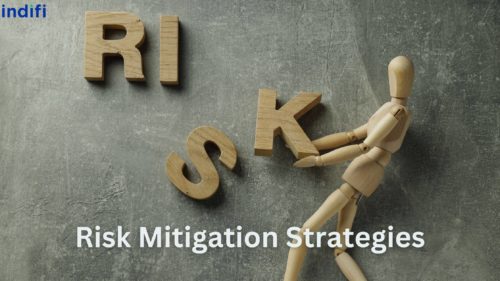
Owning a small business or startup is exciting but comes with its own share of challenges. As a first time small business owner, it is understandable you’ll know everything about running a business smoothly.
Additionally, in the ever changing business environment, uncertainties are inevitable and hence the importance of risk mitigation strategies cannot be ignored.
In this piece, we’ll dig deep into what risk mitigation is and the reasons why it is important for your business.
Also Read:- 7 Ways to Avoid Failure of Startups
Table of Content
- What is Risk Mitigation
- Types Of Risk Mitigation Strategies
- 6 Risk Mitigation Strategies for Small Businesses
- Benefits of Risk Mitigation
- FAQs
What Is Risk Mitigation?
Risk mitigation can be defined as a well defined process of identifying, assessing, managing and taking steps to control the impact of potential risks.
In brief, it refers to the techniques benign employed to bring the overall risk level down for your small business or startup.
Successful small businesses recognize that effective risk management is one of the key factors that contribute to a solid foundation for their growth. How to register as a small business in India get complete details.
Types Of Risk Mitigation Strategies
There are different ways to handle risks in business. Here are some common strategies:
Risk Acceptance: This means agreeing that the risk exists and deciding not to change it. It’s usually the last option when other solutions aren’t possible.
Risk Avoidance: This involves trying to completely steer clear of the risk. It could mean canceling the project, not starting it, or changing its design. Avoiding risk is better than dealing with its consequences later.
Risk Reduction: This is about making changes to lower the chance or impact of a risk. It’s used when the risk’s consequences are serious but not enough to avoid it altogether. For example, providing more training, adding safety measures, or using better materials.
Risk Transfer: This is when you shift the responsibility of the risk to someone else. It’s used when the risk’s consequences are serious but avoiding it isn’t an option. You can transfer risk through insurance, warranties, or agreements with service providers. It could also mean assigning the risk to another department or business.
Risk Monitoring: This involves keeping an eye on risks, watching for any changes, and updating records. It’s chosen when a risk isn’t too serious and can’t be reduced. Monitoring risks can be as simple as setting up alerts or having regular meetings. If a risk becomes more serious, a team can step in and choose another strategy. You can track risks using a Risk Matrix.
6 Risk Mitigation Strategies For Small Businesses
1) Identify And Understand Your Risks
The first step in a risk and mitigation plan is to recognize the potential risk that your business could face. This can either be reputational, legal, financial or operational risks.
2) Develop Comprehensive Risk Mitigation Techniques
Once the risks have been assessed, it’s time to focus on developing a comprehensive mitigation strategy. Risk mitigation strategies could include purchasing insurance, implementing internal controls etc designed to either decrease the chances of risk or minimise their impact.
3) Create a Strong Financial Base
Financial instability is one of the prime reasons because of which many startups or small businesses often face challenges, leading to setbacks or even failure, in some cases.
Also Read:- Best Business Ideas For Students To Start In College Life.
To mitigate financial risks, it is important to build a cash reserve to cover unexpected expenses. It is also recommended to keep a track of your finances by regularly reviewing the budget.
4) Monitor And Review Risks Regularly
Risk management is an ongoing process and hence monitoring and reviewing risks regularly is of utmost importance. This process ensures the effectiveness of the risk and mitigation plan.
5) Incorporate Risk Management Into Business Processes
The integration of risk management into regular business activities and processes is essential so that handling risk becomes a crucial part of the decision making process.
6) Diversify Client Base
Depending on a small or fixed number of customers can be risky for a small business. In such cases, losing a major client impacts the revenue of your business significantly.
To reduce chances of such risk, one must focus on expanding the customer base. This can be done via offering multiple products or services and building good relationships with existing customers.
Benefits of Risk Mitigation
Here are a few benefits of mitigating risk for small businesses:
Financial Stability: Successful risk mitigation strategy acts as a protective net for your finances. By addressing potential financial threats in advance, the likelihood of financial setbacks gets reduced to a large extent.
Informed Decisions: Risk mitigation plan provides you with valuable insights related to your business. This in turn allows you to make informed decisions about your strategies, investments, and more leading to a better scope of financial growth.
Long Term Sustainability: A proactive approach to risk and mitigation plan leads to long term sustainability for your business. Addressing risks at an early stage helps to create a strong foundation for your business.
To conclude, developing a mitigating risk plan should be a core operation of growing your small business or startup. While risk is inevitable in any kind of business, developing a solid risk management plan can lead to long term success and growth for your business.
Are Risk Mitigation Plan / Strategies Are Effective?
To see if your Risk Mitigation plan / strategies are doing their job, follow these simple steps:
- Planning: First, make a plan for how you’ll check if the plans are working. Decide what things you’ll look at and how you’ll do it.
- Gathering Information: Get info on how well the Risk Mitigation plans are doing. You can do this by asking people questions, doing interviews, or using other ways to find out.
- Looking at the Info: Check the info you gathered to see if the plans are doing what they’re supposed to.
- Sharing Results: Tell the people who need to know—like the bosses—what you found out.
- Making Improvements: Use what you learned to make the Risk Mitigation plan even better.
FAQs
Why is risk mitigation important for startups?
An effective risk mitigation strategy in place helps startups/ small businesses to prepare in advance for the unexpected. Not only this, but also it saves time and provides valuable guidance for informed decision making.
What are some of the examples of risk mitigation in business?
Some of the common examples of risk management include framing policies for security and data protection, establishing business disaster recovery plans, to name a few.
Is risk mitigation a one time process?
No, risk mitigation is an ongoing process. The strategy should be monitored regularly to ensure they remain effective with your business goals and objectives.

